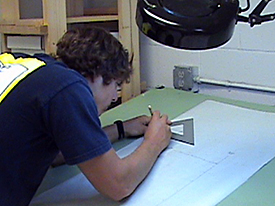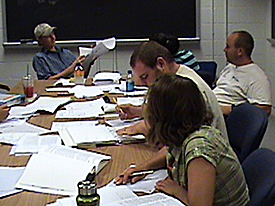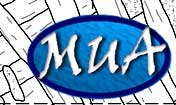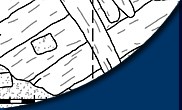
Pulling it Together
28 July - 1 August 2008
By Team 1: Chris Barron, Amanda Wohlberg, and Jake Shidner

Chris working on the site plan for EPII.
With only two weeks of work remaining for us at the UWF Maritime Archaeology Field School, we decided it was about time that we begin to draw together all the work we have been doing over the summer to give us a clearer picture of the site and what it’s telling us. The plan for the day was to be a half day, only two total dives, in order to allow us to clean up Marine Services when we returned from diving which we put off on Friday for an extra dive. Each team’s objective for their dive was to clear up any concerns in measurements and drawings so collaborative work tomorrow would be more complete. Being slightly unprepared for such an objective it was difficult at first to determine which measurements or drawings were of the most concern. However we still did our best re-investigating parts of the hull and other ships structure in the northern units of the site. Our work from today and for the entire summer of work will be brought out tomorrow as we begin to bring together a cumulative depiction of the Emanuel Point II shipwreck.

Students working on final project.
Tuesday was a little different from most days. Instead of diving and doing field work it was decided that the field school should meet at the Maritime Conservation Lab and work on the paperwork side of archaeology. The goal of the day was to create an updated site plan, analyze artifacts, and create a narrative that described the units excavated, future units that could be dredged, and features that are being seen in the units. It was also a day to help students build a better understanding of ship construction.

UWF’s Dr. John Worth inspecting a glass bead fragment found on EPII this summer.
Chris decided that he wanted to draw the site plan therefore he set up a scaled drawing of all six grids that have been fully or partially excavated at this point by our group. Jake started organizing the artifacts that were found in those units by levels and types to help create a better picture of any trends or patterns that may be occurring. Amanda started summarizing every level in every unit excavated and incorporated details of sediment consistency, artifacts, measurements, etc. Once Jake had finished organizing the artifacts Jake and Amanda began to put all the information together.
After a lunch break the field school convened into a lecture room where Greg Cook gave a lecture on ship construction in 16th century ships. The lecture touched upon common seafaring vessels found during this time period, unique features of shipbuilding, and other known 16th century shipwrecks that had been excavated. After the lecture the team decided what measurements they still needed for the site and who was responsible for what paperwork. Overall the day was a great success.
Wednesday started off with a few questionable clouds, but the field school decided to take a chance anyway. We got the first two teams into the water and then started watching the weather. The rule of thumb is that we will dive in rain but once thunder or lightening starts we end dives and return to shore. Everyone was watching a cloud build and get darker to the northwest. Pretty soon we were watching the rain come at us and we were in a torrential rain. After being soaked it looked as if we were going to be able to get a full dive in. But once the storm hit the land it just stopped moving and built up even stronger. Pretty soon there was lightning and thunder and the storm was going to change direction and come back at us. We recalled the divers, broke down the barge, and headed for shore, calling it a day.
The plan for Thursday was to conduct excavations on both EP II and the Brick wreck, as well as dive targets that had been discovered on previous surveys. However, the weather had different plans. As soon as we made it to the barge, one of the heaviest rains of the summer began to fall on us. We called it a day, and hoped that Friday’s weather would be more agreeable.

Wayne giving the walking tour at the Naval Live Oaks Sanctuary.
Due to poor weather conditions, we decided not to conduct excavations on Friday, but rather we visited the Gulf Islands National Seashore and the Naval Live Oaks Sanctuary. The Naval Live Oaks Sanctuary is a collection of trees that were used for ship construction. An attribute of the wood is resistance to disease and decay, thus the live oak is ideal for shipbuilding. The tour through the sanctuary illustrates how a shipwright would have selected trees so that the cut timbers would be in one piece, and make use of bends in the tree to make the most of that strength.
Photos from our “Pirate Day” Party.
After visiting the Sanctuary, we returned to Marine Services for a cookout. Today was designated “Pirate Day”, and everyone dressed up as a pirate for group pictures, fun and food. It was a nice day to relax and enjoy time with the many friends we have made these past few weeks, as our time together is nearing a close with only one week of field school remaining.
Please feel free to contact us if you have any questions or concerns at: mua@keimaps.com.
Return to Project Journal home page.

